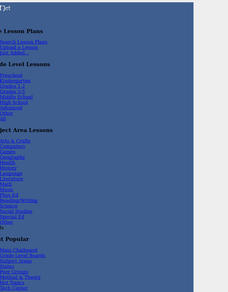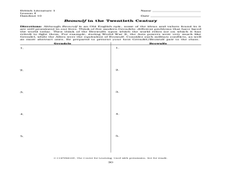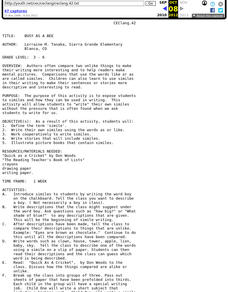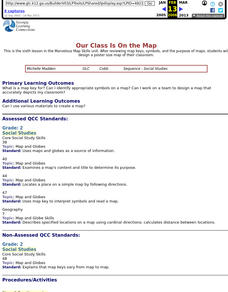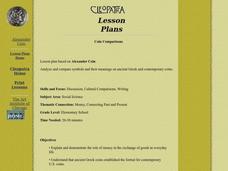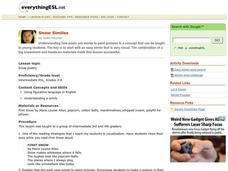Curated OER
Author Study
Students focus their attention on the study of one author's works - not just one book, but a variety of works written by the same author - to discover what themes and/or other commonalities might run throughout the body of one person's...
Curated OER
Character and Class
Students connect photographic images with the literary texts of Eudora Welty and William Faulkner. They identify and distinguish narrators and protagonists of literary works. Students recognize patterns of social class as a literary...
Curated OER
Virginia Woolf: A Room of One's Own - Shakespeare's Sister
Pupils, after reading and analyzing, "A Room of One's Own," by Virginia Woolf, analyze how creating and defending one's position as well as how narrative functions as a rhetorical device. They evaluate and focus in on Shakespeare's Sister.
Curated OER
The Concept of the Hero
Students explore the symbolic implications for the concept of the hero with a focus on the Beowulf theme. In this hero concept lesson, students find specific examples of monsters from Beowulf to complete the chart. Students list the...
Curated OER
Anglo-Saxon Period: An Introduction
Pupils read information about Anglo-Saxon rulers and literary techniques, then complete a worksheet to help them review. Students take notes about the oral tradition, Anglo-Saxon literary terms, and Anglo-Saxon poetry. Pupils create a...
Curated OER
Split Character Studies in Crime and Punishment
Learners identify characters who exhibit conflicting character traits. In this Crime and Punishment lesson, students identify and discuss characters who have opposing character traits. Learners relate their character study to...
Curated OER
Gilbert Munger Lesson Plan Ideas
Students read the biography of Gilbert Munger and analyze art that reflects the beauty of nature. In this art analysis lesson, students view a realistic image of Salt Lake City and lake over 100 years ago.
Curated OER
Are You Money Smart?
Learners figure out and discuss the irony of this coin-centric poem. They also practice persuasive letter writing, and identify and count coin/money values.
Curated OER
Busy As a Bee
Students define the term 'simile,' write their own similes using the words as or like, and work cooperatively to write similes. In addition, students write stories that include similes and illustrate picture books that contain similes.
Curated OER
Our Class Is On the Map
Second graders review map keys, symbols, and the purpose of maps, then students design a poster size map of their classroom.
Curated OER
Coin Comparisons
Learners analyze and compare symbols and their meanings on ancient Greek and contemporary coins.
Curated OER
Personal Mummy Case
Young scholars create a papier mâché mummy case covered with personal symbols from students' lives.
Curated OER
Portrait Propaganda
Students design an installation for a portrait of Hadrian in an ancient Roman town to illustrate and comprehend its propaganda role in daily life.
Curated OER
Using Alliteration in The Z was Zapped
Students discuss alliteration and how it is used in the book The Z Was Zapped. Students choose a letter and create alliterative sentences and illustrate the letter.
Curated OER
Visual Poetry Lets Students 'See' The Words
Students read a favorite poem and create a Power Point slide show depicting a visual interpretation of the images in the poem.
Curated OER
THIS WEEK'S WEATHER
First graders create a picture graph representing their town's weather for one week.
Curated OER
Snow Similes
Students see how poets use words to paint pictures. The combination of a big snowstorm and hands-on materials make this lesson plan successful. There are some nice attachments that the students will really enjoy!
Curated OER
Hyperbole
Young scholars define the term hyperbole and determine when it is appropriate to use hyperboles in writing. They work in pairs to develop short stories and poems with examples of hyperboles.
Curated OER
Imagery
Learners listen to poetry and discuss the imagery. They write a creative poem demonstrating imagery. They write about imagery of a picture and visit a website to read poetry tips. They evaluate poetry using an evaluation form.
Curated OER
Caesar
Students examine patterns of imagery in Caesar by using online resources. Students compare the patterns they see to those they've found in other Shakespeare plays. Then students draw conclusions about why Shakespeare might have used the...
Curated OER
King Lear
Students examine patterns of imagery in King Lear by using online resources. Students compare the patterns they see to those they've found in other Shakespeare plays. Then students draw conclusions about why Shakespeare might have used...
Curated OER
Hamlet
Students examine patterns of imagery in Hamlet by using online resources. Students compare the patterns they see to those they've found in other Shakespeare plays. Then students draw conclusions about why Shakespeare might have used the...
Curated OER
Richard II
Pupils examine patterns of imagery in Richard II by using online resources. Students compare the patterns they see to those they've found in other Shakespeare plays. Then pupils draw conclusions about why Shakespeare might have used the...
Other popular searches
- Teaching Literary Devices
- Literary Devices and Terms
- Literary Devices & Quotes
- Common Literary Devices
- Literary Devices and Reading
- Introducing Literary Devices
- Literary Devices Irony
- Glossary of Literary Devices
- Literary Devices Inkheart
- Literary Devices Music
- Literary Device Flashback
- Ell Literary Device Activity
